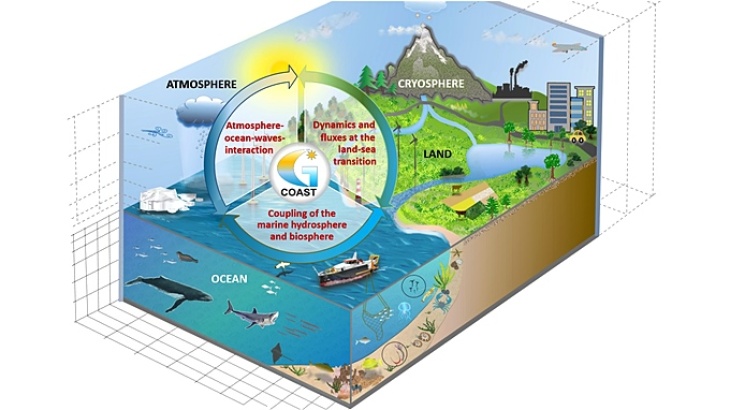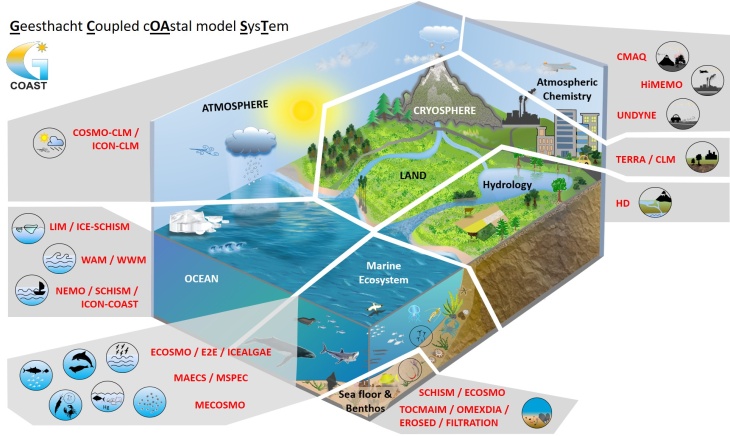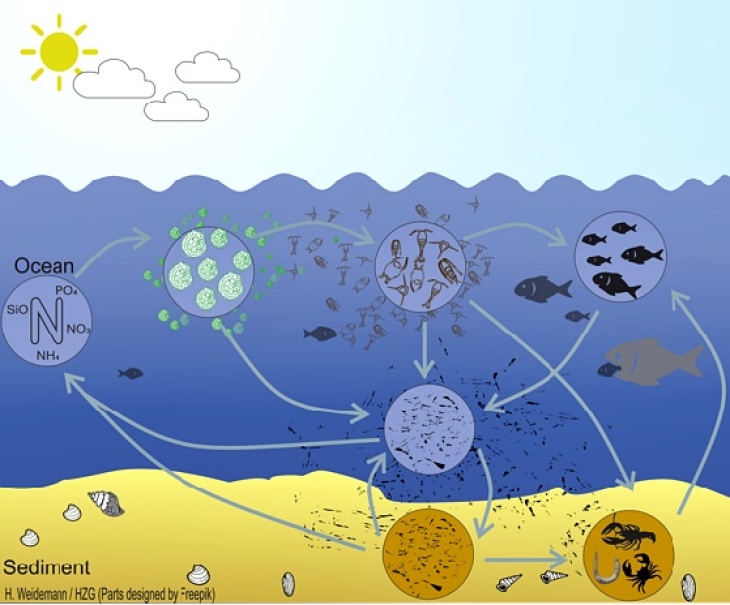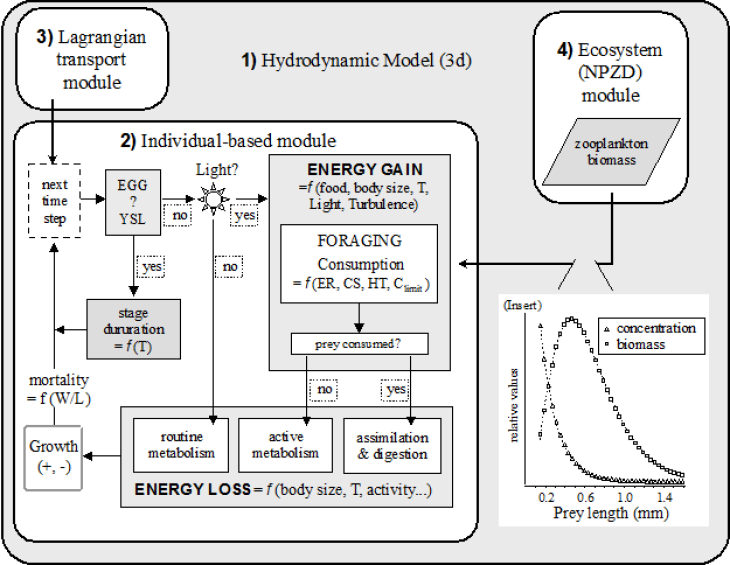Framework GCOAST

Modular model system GCOAST (Graphic: Ha Hagemann / Hereon)
Framework GCOAST (Geesthacht Coupled cOAstal model SysTem)
The GCOAST (Geesthacht Coupled cOAstal model SysTem) is built upon a flexible and comprehensive coupled model system integrating the most important key components of the regional and coastal systems and, additionally, allowing to include information from observations. In total it encompasses three major model pathways:
Triggered by the need for novel modelling capacity, the GCOAST system is designed to handle cross compartment fluxes of water and energy between the atmosphere and ocean through the dynamic wave interface, dynamics and biogeochemistry in the land ocean transition and marine ecosystems and benthic-pelagic coupling, transport and transformation of environmental pollutants.
GCOAST in applications
Wiese et al. (2019) studied the effects of the coupled COSMO-CLM/WAM models on the atmospheric planetary boundary layer. The improved prediction of wave height and surface winds by applying a coupled atmosphere/wave model was shown by Wahle et al. (2017). It has been demonstrated that coupling between waves and ocean models increase the sea level in the coastal areas (Staneva et al., 2017, Ponte et al., 2019), changes sea temperature and salinity (Alari et al., 2016, Schollen et al., 2017, Staneva et al., 2018), mixing and ocean circulation (Staneva et al., 2017), upwelling (Wu et al., 2019), leading to better agreement with in-situ and satellite measurements (Staneva et al., 2017, Cavaleri et al., 2018; Staneva et al., 2019).
Comparisons with available atmospheric and oceanic observations also showed that the use of the coupled system reduces the prediction errors in the coastal ocean especially under severe storm conditions (Mey-Frémaux et al., 2019, Staneva et al., 2019, Lewis et al., 2019) and is of crucial importance for drifter simulations (Staneva et al., 2018). The internal model variability is pronouncedly reduced during extreme events such as heavy storms when coupling atmosphere, hydrology, ocean and sea ice models (Ho-Hagemann et al., 2020) or when coupling atmosphere and wave models (Wiese et al., 2020).
In a study on biogeochemical processes in the Elbe estuary, Pein et al. (2019) demonstrated the systems capacity to simulate processes in a coupled hydrosphere-biosphere modeling framework. Multi-model couplings developed by Lemmen et al. (2018) have been, e.g., applied for assessing ecosystem impacts of offshore wind farms (Slavik et al. 2019).
GCOAST is a modular system of different models each developed for a specific earth system compartment. Based upon a specific scientific question different models from GCOAST can be selected for use. These models can be plugged together by couplers (OASIS3-MCT, ESMF, FABM) at different levels of coupling granularity, which handle the exchange of information between model combinations, individual models, and processes.
GCOAST combines the efforts of a number of working groups at the institutes within the Helmholtz Research Field Earth and Environment. The groups from the Institute of Coastal Systems develop and apply different GCOAST model components for their scientific research.

(Graphic: Ha Hagemann / Hereon)
The group “Regional Land and Atmosphere Modeling” uses and develops the regional atmospheric models COSMO-CLM and ICON-CLM which include already a component for Land/Surface/Soil and Lakes, and the hydrological discharge model HD.
The group “Hydrodynamics and Data Assimilation” contributes to the ocean models NEMO and SCHISM, wave model WAM, WWM and drifter models.
The group “Ecosystem Modeling” develops and applies multi-level coupling infrastructure through ESMF and FABM, ecological models for suspended matter, the pelagic and benthic domains (MAECS, MSPEC) and the sea floor OMEXDIA for near-shore and estuarine research.
The group “Matter Transport and Ecosystem Dynamics” utilizes and develops the ecosystem model ECOSMO, the ocean-biogeochemistry model ICON-COAST as well as models for marine chemistry and benthic processes.
The group "Sediment Transport and Morphodynamics" utilizes SCHISM to investigate sediment transport and morphodynamics, and coupled ECOSMO-TOCMAIM to estimate the impact of benthic biota on early diagenesis of particulate organic carbon (POC).
The group "Chemistry Transport Modeling" of the Institute of Coastal Environmental Chemistry uses and develops the models CMAQ, HiMEMO and UNDYNE for atmospheric chemistry transport processes.

(Graphic: Ha Hagemann / Hereon)
- Christiansen N, Carpenter JR, Daewel U, Suzuki N and Schrum C (2023). The large scale impact of anthropogenic mixing by offshore wind turbine foundations in the shallow North Sea Front . Mar. Sci . 10:1178330. https://doi.org/10.3389/fmars.2023.1178330
- Grayek, S., Wiese A. , Ho-Hagemann, H. T. M., Staneva, J., (2023): Added Value of Including Waves into Coupled Atmosphere-Ocean Model System within the North Sea Area, Frontiers in Marine Science, DOI 10.3389/fmars.2023.1104027
- Akhtar, N., Geyer, B. & Schrum, C. Impacts of accelerating deployment of offshore windfarms on near-surface climate. Sci Rep 12, 18307 (2022). https://doi.org/10.1038/s41598-022-22868-9
- Akhtar, N., Geyer, B., Rockel, B. et al. Accelerating deployment of offshore wind energy alter wind climate and reduce future power generation potentials. Sci Rep 11, 11826 (2021). https://doi.org/10.1038/s41598-021-91283-3
- Stacke, T. and Hagemann, S. (2021): HydroPy (v1.0): a new global hydrology model written in Python, Geosci. Model Dev., 14, 7795–7816, https://doi.org/10.5194/gmd-14-7795-2021
- Staneva, J., Grayek, S., Behrens, A., & Günther, H. (2021): GCOAST: Skill assessments of coupling wave and circulation models (NEMO-WAM). Journal of Physics: Conference Series, Vol. 1730, 01207I, doi:10.1088/1742-6596/1730/1/012071
- van de Wolfshaar KE, Daewel U, Hjøllo SS, Troost TA and others (2021) Sensitivity of the fish community to different prey fields and importance of spatial-seasonal patterns. Mar Ecol Prog Ser 680:79-95. https://doi.org/10.3354/meps13885
- Akhtar, Naveed; Chatterjee, Fabien (2020). Wind farm parametrization in COSMO5.0_clm15. World Data Center for Climate (WDCC) at DKRZ. https://doi.org/10.35089/WDCC/WindFarmPCOSMO5.0clm15
- Hagemann, S., T. Stacke and H. Ho-Hagemann (2020) High resolution discharge simulations over Europe and the Baltic Sea catchment. Front. Earth Sci., 8:12. https://doi.org/10.3389/feart.2020.00012
- Ho-Hagemann, H.T.M., Hagemann, S., Grayek, S., Petrik, R., Rockel, B., Staneva, J., Feser, F., & Schrum, C. (2020): Internal Model Variability of the Regional Coupled System Model GCOAST-AHOI. Atmosphere 2020, 11, 227, doi:10.3390/atmos11030227
- Wiese, A., Staneva, J., Ho-Hagemann, H.T.M., Grayek, S., Koch, W., & Schrum, C. (2020): Internal Model Variability of Ensemble Simulations With a Regional Coupled Wave-Atmosphere Model GCOAST. Front. Mar. Sci. 7:596843, doi:10.3389/fmars.2020.596843
- Daewel, U., Schrum, C., and Macdonald, J. I. (2019) Towards end-to-end (E2E) modelling in a consistent NPZD-F modelling framework (ECOSMO E2E_v1.0): application to the North Sea and Baltic Sea, Geosci. Model Dev., 12, 1765–1789, https://doi.org/10.5194/gmd-12-1765-2019
- Lewis, H.W., Castillo Sanchez, J.M., Siddorn, J., King, R.R., Tonani, M., Saulter, A., Sykes, P., Pequignet, A.-C., Weedon, G.P., Palmer, T., Staneva, J., & Bricheno, L. (2019): Can wave coupling improve operational regional ocean forecasts for the north-west European Shelf? Ocean Sci., 15, 669-690, doi:10.5194/os-15-669-2019
- Mey-Frémaux, P. de, Ayoub, N., Barth, A., Brewin, R., Charria, G., Campuzano, F., Ciavatta, S., Cirano, M., Edwards, C.A., Federico, I., Gao, S., Hermosa, I.G., Sotillo, M.G., Hewitt, H., Hole, L.R., Holt, J., King, R., Kourafalou, V., Lu, Y., Mourre, B., Pascual, A., Staneva, J., Stanev, E.V., Wang, H., & Zhu, X. (2019): Model-Observations Synergy in the Coastal Ocean. Front. Mar. Sci., 23 July 2019, doi:10.3389/fmars.2019.00436
- Pein, J., Eisele, A., Hofmeister, R., Sanders, T., Daewel, U., Stanev, E.V., van Beusekom, J., Staneva, J., & Schrum, C. (2019): Nitrogen cycling in the Elbe estuary from a joint 3D-modelling and observational perspective. Biogeosciences Discuss., (July), 1–34, doi:10.5194/bg-2019-265
- Ponte, R.M., Carson, M., Cirano, M., Domingues, C.M., Jevrejeva, S., Marcos, M., Mitchum, G., Wal, R.S.W. van de, Woodworth, P.L., Ablain, M., Ardhuin, F., Ballu, V., Becker, M., Benveniste, J., Birol, F., Bradshaw, E., Cazenave, A., Mey-Frémaux, P. de, Durand, F., Ezer, T., Fu, L.-L., Fukumori, I., Gordon, K., Gravelle, M., Griffies, S.M., Han, W., Hibbert, A., Hughes, C.W., Idier, D., Kourafalou, V.H., Little, C.M., Matthews, A., Melet, A., Merrifield, M., Meyssignac, B., Minobe, S., Penduff, T., Picot, N., Piecuch, C., Ray, R.D., Rickards, L., Santamaría-Gómez, A., Stammer, D., Staneva, J., Testut, L., Thompson, K., Thompson, P., Vignudelli, S., Williams, J., Williams, S.D.P., Wöppelmann, G., Zanna, L., & Zhang, X. (2019): Towards Comprehensive Observing and Modeling Systems for Monitoring and Predicting Regional to Coastal Sea Level. Front. Mar. Sci. 6:437, doi:10.3389/fmars.2019.00437
- Slavik, K., Lemmen, C., Zhang, W., Kerimoglu, O., Klingbeil, K., & Wirtz, K.W. (2019): The large scale impact of offshore windfarm structures on pelagic primary production in the southern North Sea. Hydrobiologia (2019) 845: 35, doi:10.1007/s10750-018-3653-5
- Staneva, J., Behrens, A., Gayer, G., & Aouf, L. (2019): Synergy between CMEMS products and newly available data from SENTINEL. In: Schuckmann, K., et al. (2019): Copernicus Marine Service Ocean State Report, Issue 3, Chapter 3.3, Journal of Operational Oceanography, doi:10.1080/1755876X.2019.1633075
- Wiese, A., Stanev, E., Koch, W., Behrens, A., Geyer, B., & Staneva, J. (2019): The Impact of the Two-Way Coupling between Wind Wave and Atmospheric Models on the Lower Atmosphere over the North Sea. Atmosphere 2019, 10, 386, doi:10.3390/atmos10070386
- Wu, L., Staneva, J., Breivik, Ø., Rutgersson, A., Nurser, A.J.G., Clementi, E., & Madec, G. (2019): Wave effects on coastal upwelling and water level. Ocean Modelling, Volume 140, doi:10.1016/j.ocemod.2019.101405
- Zhang, W., Wirtz, K., Daewel, U., Wrede, A., Kröncke, I., Kuhn, G., Neumann, A., Meyer, J., Ma, M., & Schrum, C. (2019): The budget of macrobenthic reworked organic carbon - a modelling case study of the North Sea. Journal of Geophysical Research-Biogeosciences, doi:10.1029/2019JG005109
- Cavaleri, L., Abdalla, S., Benetazzo, A., Bertotti, L., Bidlot, J.-R., Breivik, Ø., Carniel, S., Jensen, R.E., Portilla-Yandun, J., Rogers, W.E., Roland, A., Sanchez-Arcilla, A., Smith, J.M., Staneva, J., Toledo, Y., Vledder, G.Ph. van, & Westhuysen, A.J. van der (2018): Wave modelling in coastal and inner seas. Progress in Oceanography, doi:10.1016/j.pocean.2018.03.010
- Lemmen, C., Hofmeister, R., Klingbeil, K., Nasermoaddeli, M.H., Kerimoglu, O., Burchard, H., Kösters, F., & Wirtz, K.W. (2018): Modular System for Shelves and Coasts (MOSSCO v1.0) – a flexible and multi-component framework for coupled coastal ocean ecosystem modelling. Geosci. Model Dev., 11, 915-935, doi:10.5194/gmd-11-915-2018
- Staneva, J., Behrens, A., Ricker, M., Krüger, O., Wiesse, A., Carrasco, R., Breivik, Ø., & Schrum, C. (2018): Particle transport model sensitivity on wave-induced processes in the forecasting, coupled model system, Operational Oceanography serving Sustainable Marine Development. E. Buch, V. Fernández, D. Eparkhina, P. Gorringe and G. Nolan (Eds.). ISBN 978-2-9601883-3-2, 516 pp.
- Staneva, J., Schrum, C., Behrens, A., Grayek, S., Ho-Hagemann, H., Alari, V., Breivik, Ø., & Bidlot, J.-R. (2018): A North Sea - Baltic Sea regional coupled models: atmosphere, wind, waves and ocean. In: Buch, E., Fernández, V., Eparkhina, D., Gorringe, P., & Nolan, G. (Eds.): Operational Oceanography serving Sustainable Marine Development. Proceedings of the Eight EuroGOOS International Conference, 516 pp, ISBN 978-2-9601883-3-2.
- Schloen, J., Stanev, E.V., & Grashorn, S. (2017): Wave-current interactions in the southern North Sea: The impact on salinity. Ocean Modelling 111 (2017) 19–37, doi:10.1016/j.ocemod.2017.01.003
- Wahle, K., Staneva, J., Koch, W., Fenoglio-Marc, L., Ho-Hagemann, H.T.M., & Stanev, E.V. (2017): An atmosphere–wave regional coupled model: improving predictions of wave heights and surface winds in the southern North Sea. Ocean Sci., 13, 289-301, doi:10.5194/os-13-289-2017
- Zhang, W., & Wirtz, K. (2017): Mutual dependence between sedimentary organic carbon and infaunal macrobenthos resolved by mechanistic modeling. Journal of Geophysical Research: Biogeosciences, 122, doi:10.1002/2017JG003909
- Staneva, J., Alari, V., Breivik, Ø., Bidlot, J.-R., & Mogensen, K. (2016): Effects of wave-induced forcing on a circulation model of the North Sea. Ocean Dynamics, doi:10.1007/s10236-016-1009-0
- Daewel, U. & Schrum, C. (2013) Simulating long-term dynamics of the coupled North Sea and Baltic Sea ecosystem with ECOSMO II: Model description and validation. Journal of Marine Systems 119–120, 30–49.
- Stacke, T. and S. Hagemann (2012) Development and validation of a global dynamical wetlands extent scheme. Hydrol. Earth Syst. Sci. 16, https://doi.org/10.5194/hess-16-2915-2012: 2915-2933


